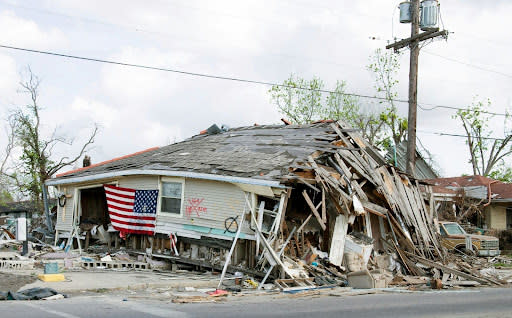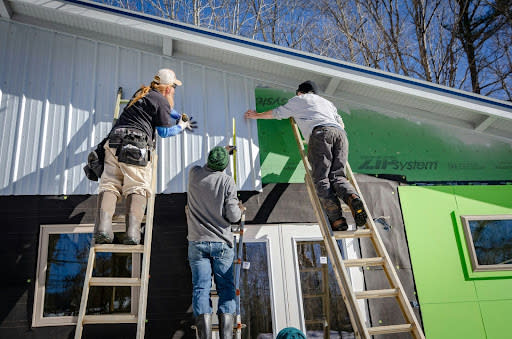U.S. housing market, economy at serious risk due to $3 trillion in uninsured homes

Insurance is a critical part of homeownership in the U.S. Without it, owning a home just wouldn't be viable, according to Douglas Heller, Director of Insurance at the Consumer Federation of America (CFA), a national nonprofit organization.
"[Imagine] if all of our resources, all of our wealth that's tied up in our home was entirely exposed," Heller told Yahoo Local. "If a bad storm comes through or a kitchen fire gets out of hand or even significant damage happens, and we were asked to rebuild with whatever money we have available, homeownership would be too risky."
Think about it. The average cost to replace a roof is just over $21,000, according to Architectural Digest. If a storm came through and you needed to replace your roof, would you be able to without insurance? What if you needed to repair your roof, your windows and your garage out of pocket?
The reality is that over 10 million American homeowners could be or soon find themselves in a situation just like that.
Alarming rise in uninsured homeownership
A 2023 Insurance Information Institute study found that 12% of U.S. homeowners haven't purchased homeowners insurance. Similarly, a recent CFA report found that 7.4% of American homeowners were uninsured in 2021. That represented 6.1 million homeowners, meaning the number could be over 10 million in 2024, based on the Institute's growth figure from 2023. That's an increase of over 60% – an alarming rise in uninsured American homeowners. If premiums continue to rise, this number could also increase.
This trend has been building for a while, according to Mark Friedlander, Insurance Information Institute (III) director of corporate communications, who says the uninsured homeowner rate before the COVID pandemic was just 5%. "Our 2023 survey showed an alarming trend, as few Americans can realistically afford to pay for rebuilding their home following a catastrophe without adequate insurance coverage," Friedlander said.
It's also not only a lack of homeowners insurance that's worrisome. In its 2024 publication, the CFA estimated that American homeowners owned $1.6 trillion in uninsured property, and the group says that's a conservative estimate. Using updated numbers from III and an average annual home value increase of 4% from Credit Karma's review of historical data Yahoo Local calculated that there may now be around $2.9 billion in uninsured homes in the U.S.
Looking at 2021 data, the Consumer Federation of America stated that "the precarity of the homeowners insurance market poses a systemic risk to our nation’s housing markets."
"Imagine a series of homes in a neighborhood that was forced to make that terrible choice of being uninsured because the market was too expensive for them," Heller said, "or the [insurance] company simply had walked away from the communities, which is happening a lot … [If] those homes get damaged or destroyed and there are no resources to rebuild, that leads to blight." Such visible signs of neglect reduce a neighborhood's value, which affects the community in the form of lessened livability, reduced market value and lost equity, according to Heller. In 2005, he says, after Hurricane Katrina, there was a community exodus because residents couldn't rebuild and eventually had to find somewhere else to live.
The threat of blighted neighborhoods and lost equity doesn't just affect underinsured neighborhoods either, according to Heller. If the nation loses whole neighborhoods, especially those where lower-income homeowners live, the housing crises in other locations increase, creating a national economic impact.
"Insurance is absolutely essential to financial security and wellbeing and community resilience," Heller says.
In other words, the rising number of uninsured homeowners in the U.S. is a big deal for the majority of its citizens and could have a huge effect on the future housing market – and the U.S. economy.
Rising costs drive homeowners' lack of insurance

Why are so many homeowners living without insurance? Rising costs and general inflation are likely part of the answer.
According to market research firm S&P Global, the average home insurance premium increase in 2023 was 11.3%. Twenty-five states saw an average increase of over 10% in 2023, compared to only six states in 2022. The largest premium increases were in Texas (23.3%), Arizona (21.8%) and Utah (20.3%), while Hawaii (1.8%), Vermont (3.3%), Delaware (3.9%) and Mississippi (3.9%) saw the smallest changes. A total of 61% of the 1,500 homeowners surveyed by insurance information resource ClaimGuide.org said their premiums had gone up in the past year.
"It's safe to say that the number of people going without homeowners insurance is on the increase as premiums continue to rise," said Lisa Gill, reporter for Consumer Reports, "and that that trend is alarming [and] it's dangerous."
Rising costs have a disproportionate effect on low-income homeowners, who are more likely to go without insurance; 22% of homeowners living below the federal poverty line don't have homeowners insurance, according to the CFA report, and homeowners of color are significantly more likely to be uninsured than white homeowners.
What's driving the rapid rise of homeowners insurance costs?
Most homeowners (86%) think insurers are using inflation as an excuse to raise premiums, according to the ClaimGuide.org study. They might be right.
Heller outlined four reasons premiums have exploded. First, climate change increases the risk of damaging weather events around the country.
"We've got to be very careful not to fall prey to the misunderstanding that climate change is a coastal problem," Heller said. "This is not a problem of tropical storms in the Gulf and Atlantic seaboard and wildfires in the West." One key driver of climate-related catastrophic losses in America is severe convective storms and hail through the center of the country, he says.
Second, reinsurance companies – essentially insurance companies for insurance companies – are unregulated global businesses that can raise prices whenever they want. When local regulations don't prevent it, those increases are passed directly to consumers. Many reinsurers are posting record multibillion-dollar profits, though Consumer Reports' Gill notes they may also be nervous about climate change, global trade, wars, and other international events, leading to less appetite for serving as a safety net for insurance companies.
The third reason is inflation. "The insurance companies continue to price insurance as though we're still at that eight or nine percent inflation that spooked everybody in 2021 and 2022, when inflation is significantly down," says Heller. He also says poor investment returns in 2022 affected insurance companies, whose profits largely come from investing money between when you pay your premium and when you make a claim.
Finally, we come to regulators. A 2022 study by researchers from Columbia University, Harvard University and the U.S. Federal Reserve System found that states with stricter regulations on raising premiums saw lower rate increases. It also found that those same insurance companies raised rates more in less-regulated states. Increases also aren't always consistent with risk. Insurance companies appear to raise rates in less-regulated states because it's harder to raise rates in more-regulated ones even if homes in those less-regulated states are safer.
The New York Times published an investigative article that shows this scenario playing out in communities around the U.S. The effects are quite complicated, but uneven sharing of climate risk means many homeowners paying more than their fair share – to the point where people in lower-risk areas have been forced to sell their homes to look for more affordable options.
The "free market" approach to insurance in lower-risk areas just isn't working, according to Heller, and regulators are running scared. They're afraid insurers will stop insuring homes in their states – which has been happening not just in California and Florida, but also in Minnesota, Oklahoma, South Carolina, and other states, according to Newsweek – so they let them raise rates.
"I think all these state regulators around the country are scared that will happen to them too," he said. "So they've just been passing through every rate increase and not responding to the fact that inflation has come down [and] investment markets are back up."
Regulators may have buckled to the threat of insurance companies, and insurance premiums seem likely to continue rising. Most regulators appear to be unwilling to force the issue with big insurers. And banks, who own the houses under discussion and require tenants to carry insurance, aren't interested in using their considerable power to push for change.
So what can homeowners do to survive premium increases?

Collin Czarnecki, a ClaimGuide.org researcher, suggests making improvements, such as investing in home security and updating your home's wiring and plumbing. He also points out that one of the easiest ways to decrease your premium is to increase your deductible.
"Filing a homeowners insurance claim can increase your premiums, so make sure you’re taking a calculated approach before you file a claim," Czarnecki said. "If the repair costs are roughly the same as your deductible, it’s probably best to pay for them out of pocket."
For the millions of homeowners already feeling the crunch from increased premiums, spending additional money on updating their homes may not be an option. Increasing your deductible also exposes you to more risk from catastrophic events, which are becoming increasingly common.
Consumer Reports' Gill has advice that doesn't require consumers to spend more money or take on more risk. "The first step is finding a broker, an independent broker, a real person in your area, who can work with you on getting quotes from every place possible that will cover your community or your state," she says.
Gill recommends trying to bundle your home insurance with auto or life insurance to get a better deal, as well. Also, check your credit report regularly. "There is a component [of insurance] that does rely, for better or for worse, on your credit score," Gil said. You can check your score online at sites like AnnualCreditReport.com. You may also be able to get a simple credit report from your bank or credit card company.
Will bundling insurance policies, checking credit reports, and making home improvements make homeownership more affordable?
If premiums continue their staggering rise, it may not, which is why consumer advocacy groups like the CFA continue to communicate the importance of consumer-focused legislation to regulators. So, yes, replace your wiring and reinforce your roof. Bundle your insurance policies. However, you should also support the organizations and politicians willing to stand up to insurance companies, reinsurance markets, and unequal distribution of risk.


